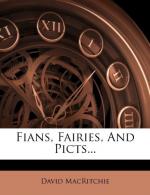“’There are in the island of Sylt hillocks of ancient origin, for the most part pagan burying-places, but some of which may have served as the dwelling-places of a primitive people. One such hillock has just been opened at Wenningstedt. The interior was found to be a chamber, 17 feet long, 10 feet in breadth, and from 5 to 6 feet in height, with a covered passage about 22 feet long, trending southward. The walls of this underground room were composed of twelve large granite blocks, regularly arranged; the roof consisted of three still larger slabs of the same kind of rock; the stones which formed the passage were smaller. At one corner of the floor of the cellar there was a well-defined fireplace, and near it were urns and flint implements; in the opposite corner there were many bones lying, apparently unburned, probably those of the last dweller in the cavern.’”
Mr. Christian Jensen gives an account of “Der Denghoog bei Wenningstedt” in the “Beilage zu Nr. 146 der Flensburger Nachrichten” of 25th June 1893, in which he says:
“... On the floor of the chamber, three separate divisions were distinctly visible, of which one, situated on the east side, showed traces of having been a fireplace. Professor Wibel found several fragments of human bones, which evidently belonged only to one individual, as no portion was duplicated; also a few animals’ bones. There was an extraordinary number of fragments of pottery, belonging to about 24 different urns, of which 11 could be put together. Their form and ornamentation were both fine and varied, an interesting witness to the ceramics of the grey past.... Among the stone implements found were a great many flint-knives; two stone hatchets, two chisels, and a gouge, all of flint, and a disc of porphyry were also obtained. Several mineral substances, quartzite, rubble-stones, gravel, ochre, a sinter-heap—these are less interesting than the seven amber beads which, with some charcoal, completes the list of objects found. Referring to former investigations of galleried mounds [gangbauten], which seem to have been used in some cases as burying-places, in others as dwellings, Dr. Wibel observes, in answer to the question resulting from his discovery, as to whether the Denghoog ought to be regarded as a sepulchre or as a dwelling, that, as Nilsson has already said, all gallery-mounds were originally dwellings, and occasionally became utilised as tombs. In the case of the Denghoog, this fact is demonstrated by the fireplace, the scattered potsherds, the amber beads, &c.”
[Footnote 93: Heligoland, Edin. and Lond., 1888, pp. 84-85.]




